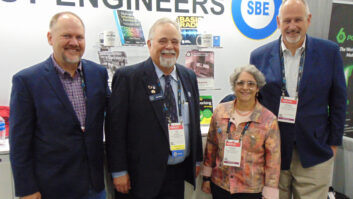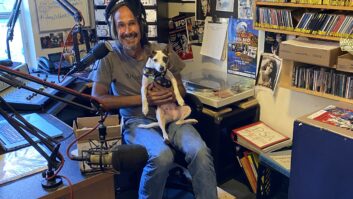If you want to learn the history of a couple of great Philadelphia AM radio stations, seek no further than Fred Moore, now the chief engineer of AM stations WFIL and WNTP, which was once WIBG – “Wibbage.” The stations, once fierce competitors, now air from the same studio facility and are owned by the same company, Salem.
Moore, who retires this year, was an engineer at “Famous 56 WFIL” from 1966 to ’72. During what is considered by many to be the “glory days” of top 40, the little 5 kW David, operating at 560 kHz and owned by Triangle Publications, which ran the Philadelphia Inquirer and TV Guide, dethroned Buckley Broadcasting’s 50 kW Goliath WIBG, on 990. The latter had been the dominant Delaware Valley music station in the late 1950s and ’60s.
WFIL-WNTP Gear ListAir Studios
Audioarts R-60 consoles ENCO DADpro32 automation Audiometrics CD-10-E and Denon DN-951 CD players Sennheiser MD-421 mics Symetrix 610 delay Sony MDS-E11 MiniDisc decks Marantz PMD-510 cassette Otari MX-50 reel-to-reel Tascam DA30 MkII DAT Telos Zephyr Layer III ISDN codecs Minnetonka Software Fast Edit v4.1 editing software
Production Room
Audioarts MR-40 console Audiometrics CD-10-E CD players Sennheiser MD-421 mic Marantz PMD-510 cassette Otari MX-50 reel-to-reel ITC 3D & Series 1 cart machines Panasonic consumer VCR Tascam DA-88 ADAT HHB CD-R 850 CD burner Editing Software: Sonic Foundry Sound Forge 6.0 (2 track) Sonic Foundry Vegas 4.0 (multi track) Adobe Audition 1.0
Air chain
Burk ARC 16 remote controls Sage Endec EAS Orban Optimod 9100B (WFIL) Orban Optimod 9100A processor (WNTP)
WFIL:
Harris DX-19 transmitter Nautel Amphet 10 aux Carl T. Jones Co. custom phasor
WNTP:
Harris DX-50 transmitter Harris MW-50, Nautel Amphet 5 (aux) Phasor: Vector Technology Carl T. Jones Co.
Kintronic DL-50 dummy load Magnum towers
After engineering stints in the Big Apple at WPAT(AM-FM) and WNEW(AM-FM), Moore returned to the City of Brotherly Love in 1993 to wear the hat of chief engineer at WBEB(AM), the former WFIL. Salem purchased the station in November of 1993 from Jerry Lee, owner of perennial market leader WBEB(FM).
Lee had tried several formats on the AM in the ’80s including a run at an oldies format and was airing beautiful music instrumentals with the ID of WBEB(AM). When Salem took over, the station changed to religious WPHY. Eventually, General Manager Russ Whitnah was able to reclaim the WFIL calls when they became available.
Less than a year later, Salem acquired the former WIBG. It had been re-christened WZZD around 1978 in an attempt to revive the station’s sagging ratings. “Wizard 100” played a disco format. The dancing stopped in 1980 when owner, Unicom, began airing a Christian format.
Thus WZZD already had a religious format when Salem took over, creating a one-two punch on two of the better AM signals in the region.
Around that same time, in 1993, the suburban township of Whitemarsh, Pa., in which both stations were located, expressed a desire for the land where WFIL sat, to use as a recreational area. Lafayette Hill had become residential, and a school had been built to the west of the towers.
Faced with stations in two locations; aging studios, transmitters and towers; and legal pressure to vacate the smaller site, Salem laid plans for a multi-million dollar project that would combine and upgrade the facilities at the WZZD site on Ridge Pike a mile away.
Today, the land where the three WFIL towers once stood is occupied by softball fields. The building remains, unused; if you peer through the glass of the front door, you can still see an equipment rack in the darkness toward the back.
Salem recently changed the call letters of WZZD to WNTP, part of a format tweak to news/talk. CEO Edward G. Atsinger III called this move a “significant growth opportunity” for Salem, “part of our long-term plan of developing our three formats.”
The company quoted Philadelphia GM Russ Whitnah as saying, “Historically, WFIL(AM) and WNTP(AM) offered listeners similar programming in the Christian teaching and talk format. Our listeners now will enjoy the best of both worlds: Christian teaching and talk; and news/talk.”
After the major buildout in 1995-97, Salem operates the two stations from the WNTP complex on picturesque land adjacent to a country club. The single-lane driveway is easy to miss. If not for the six towers in the side yard, the building could be mistaken for a large home set back from the road by 50 yards. The layout, a mixture of contemporary and art deco architecture, is deeper than it is wide.
I recently visited to see and share how these legendary stations operate. (I made my visit prior to the call letter change from WZZD.)
Media mix
Integration began in the mid-1990s, as the analog and digital worlds were colliding. Moore describes the three-studio facility now as “a lot of both.”
While you see touchscreens and digital media, you also notice cart and reel equipment. Much of the programming on both stations is network and syndicated; and there are still live programs broadcast. A host may bring in his or her own spiritual music; a church may send the Sunday service for broadcast, recorded on reel.
Moore met me in the neat reception area and up the stairs to the first stop, the WNTP air studio. Neat and functional, it sports an Audioarts console with a transmitter control/monitor and a flat-screen monitor with program controller from ENCO Systems (see the sidebar for an equipment list). A television doubles as amusement for the operator during long-form programming and a link to keep abreast of worldwide developments and breaking news.
Around the corner in the WFIL studio, one can delight further in the plant’s media-diverse nature. It is billed as “Philadelphia’s Christian Talk” station. You can find everything from another Audioarts console and touchscreens to play programming off hard disk, to nearly every conceivable format of the last 50 years. There are CD cartridge machines above a dual cassette deck; directly below is an ITC tape cartridge record deck, with another one in the elevated rack. A pair of reel to reels, MiniDisc recorders, even a VCR along with a VCR/DVD combo reside here. Just about whatever media it’s on, they can play it.
Directly behind the WFIL control room is a production room that serves both stations.
The only thing missing in the building is a turntable. Moore says he had planned to have at least one, but somehow never installed it and there hasn’t been a need for one.
Working a 50
In the 1970s I learned many radio fundamentals from the late Chuck Smith, then of WIMS(AM) in Michigan City, Ind. He always said he wanted to “work a fifty.” He would be in his glory here.
Just outside the “back” door of the production studio, you are greeted by not one but two Harris 50,000-watt transmitters. In a glassed room, along with audio processing racks, sits a DX-50, the station’s main transmitter, installed during the last upgrade. It is reduced to 10 kW at night. Down the hall sits an MW-50 backup, circa 1980, built into the wall and looking as pristine as the day it was powered up.
Heading down to the basement, we stopped to gaze out a stairway window at the tower field. The six towers stand in two rows that march away from the building in two rows roughly north-south. The row on the right has four towers; the first tower is shared, transmitting on 560 and 990, while the other three complete WNTP’s array. The row on the left has two more towers for WFIL.
The complex directional patterns are controlled not by a phasing cabinet but by a phasing room. Insurance regulations would not allow me to enter due the high RF levels. But I was able to lean waayyyyyy in to get a photo of this custom maze. The Vector phasing room controls WNTP, while a smaller cabinet by the WFIL transmitter controls that station. Both units were designed and installed by Consulting Engineer Tom Jones; they control the stations’ separate day and night patterns.
About a third of the basement area is workshop and storage. In the middle the WFIL Nautel Amphet 5 backup transmitter stands next to an impressively sized Kintronic DL-50 dummy load. Around that corner is the WFIL transmitter room, featuring the primary Harris DX-10, rack equipment and a backup Nautel Amphet 10.
Because the WFIL towers here are 100 feet shorter than at the old location, in the fall of 1995 the station was allowed to compensate by retuning and increasing power from 5 kW full time to 7.1 kW during the day and 8.3 kW at night.
My tour ended as I stepped out the side door and looked up at the towers. I couldn’t help but feel that this is one of the few, high-power, major-market studio-transmitter locations remaining.
Salem seems to respect broadcast history by its general modus operandi of keeping existing plants and call letters where it can. This is evident on a portion of the original building exterior, where the original call letters “WIBG” can be seen carved in stone below the roofline. Moore said the letters are said to have originally meant “I Believe in God.”
I couldn’t help find it interesting that Salem has turned the station full circle, back to God, and took “Famous 56” along for the ride. It appears the wheel will again turn with the birth of WNTP.












